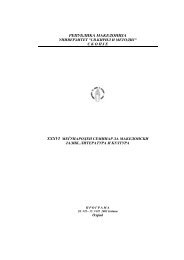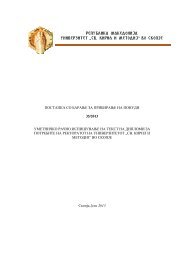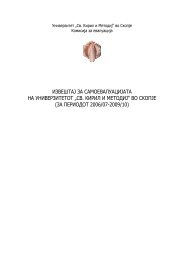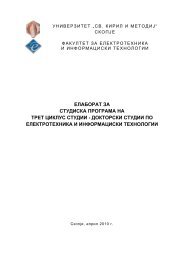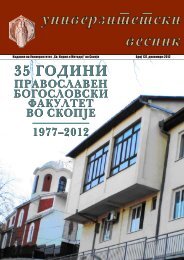УНИВЕРЗИТЕТ „СВ. КИРИЛ И МЕТОДИЈ“ – СКОПЈЕ
УНИВЕРЗИТЕТ „СВ. КИРИЛ И МЕТОДИЈ“ – СКОПЈЕ
УНИВЕРЗИТЕТ „СВ. КИРИЛ И МЕТОДИЈ“ – СКОПЈЕ
You also want an ePaper? Increase the reach of your titles
YUMPU automatically turns print PDFs into web optimized ePapers that Google loves.
Max Wahlström<br />
ON THE GRAPHEMICS OF THE KONIKOVO GOSPEL<br />
1. Introduction<br />
The Konikovo Gospel (call number Bibl.Patr.Alex.268 in the Library<br />
of the Patriarchate of Alexandria) is a Sunday Gospel that comprises a Greek<br />
source text, most likely copied from a vernacular translation of the Bible from<br />
1710 (Leiwo 2007), and a translation into Macedonian. The main features of the<br />
Macedonian side of the manuscript represent the Lower Vardar dialect that is<br />
spoken in the current Greek Republic. This manuscript by an unknown author,<br />
found in 2003, can be estimated to be approximately 200 years old (Lindstedt<br />
2006: 243). Moreover, the manuscript has, in addition to the original text, another<br />
stratum, namely, some corrections to the Macedonian text that reflect<br />
the different lexical and dialectological preferences of a second writer. This<br />
“second hand”, in light of what we now know, is Pavel Božigropski (Lindstedt<br />
2006: 237).<br />
In this article, I will analyze the graphemics of the Macedonian side of<br />
the manuscript. I will attempt to describe the writing system that the author of<br />
the Konikovo Gospel uses in the Macedonian part of the manuscript. This will<br />
be done by assuming a hypothetical phoneme inventory of the language that<br />
the author has targeted, and by then comparing that hypothetical inventory to<br />
the graphemes and other graphemic signs in the text.<br />
The most central starting point for the study of the writing system of<br />
the Konikovo Gospel is that the entire manuscript is written in Greek letters.<br />
While this manuscript is not the only Slavic text that makes use of the Greek<br />
alphabet 1 , considering the lack of a standardized and broad tradition, some of<br />
its graphemic solutions are most likely unique.<br />
1<br />
See e.g. Mazon, André & Vaillant, André. 1938. L’Évangéliaire de Kulakia. Un parler slave du Bas-Vardar.<br />
Paris: Librairie Droz ; Ničev, Aleksandăr. 1977. “Četiriezičnijat rečnik” na Daniil. Godišnik na Sofijskija<br />
universitet, Fakultet po zapadni filologii, Tom. LXX 2. Sofia: Universitetska pečatnica ; Georgievski,<br />
Kuzman. 2003. Trijazičnikot na Petre Kavajof (Prilog kon geneologijata na struškata familija Kavaevci).<br />
Skopje: Menora.






